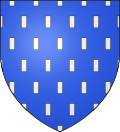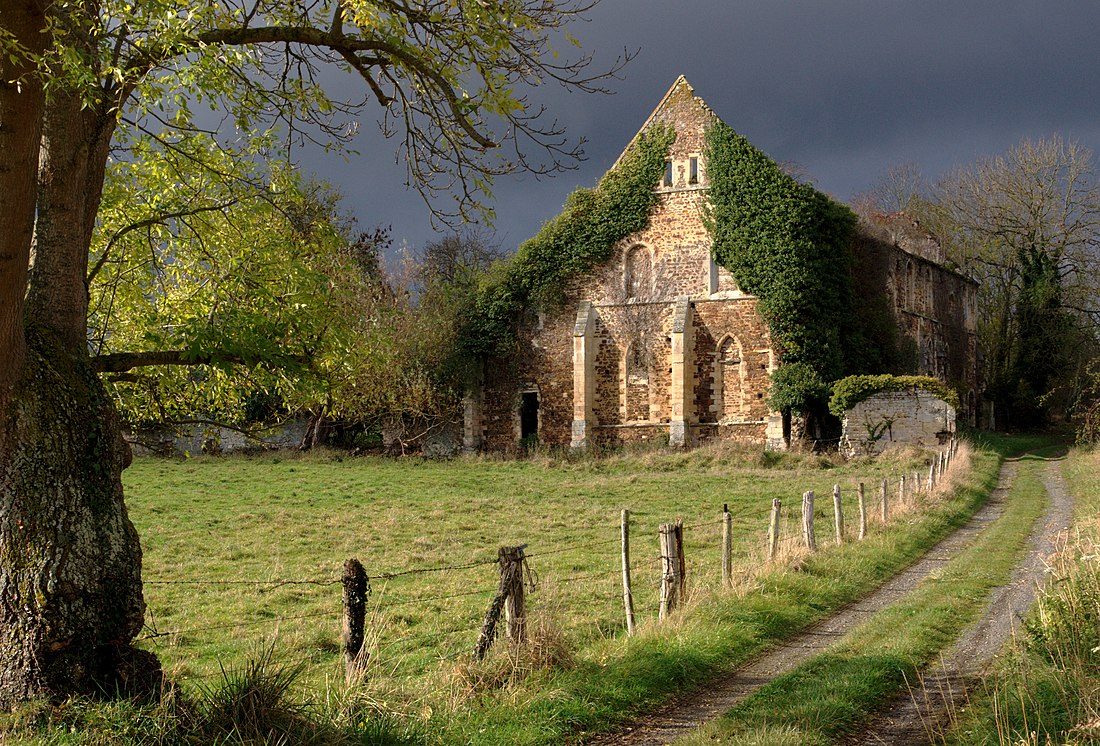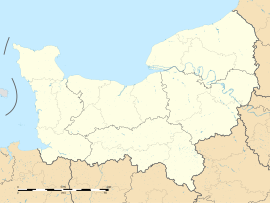Barbery, Calvados
Commune in Normandy, France From Wikipedia, the free encyclopedia
Barbery (French pronunciation: [baʁbəʁi] ⓘ) is a commune in the Calvados department in the Normandy region of north-western France.[3]
Barbery | |
|---|---|
 The old Cistercian Abbey of Notre-Dame | |
| Coordinates: 49°00′38″N 0°21′09″W | |
| Country | France |
| Region | Normandy |
| Department | Calvados |
| Arrondissement | Caen |
| Canton | Le Hom |
| Intercommunality | Cingal-Suisse Normande |
| Government | |
| • Mayor (2023–2026) | Luc Lebouvier[1] |
Area 1 | 8.6 km2 (3.3 sq mi) |
| Population (2022)[2] | 758 |
| • Density | 88/km2 (230/sq mi) |
| Time zone | UTC+01:00 (CET) |
| • Summer (DST) | UTC+02:00 (CEST) |
| INSEE/Postal code | 14039 /14220 |
| Elevation | 77–193 m (253–633 ft) (avg. 285 m or 935 ft) |
| 1 French Land Register data, which excludes lakes, ponds, glaciers > 1 km2 (0.386 sq mi or 247 acres) and river estuaries. | |
Geography

Barbery is located some 18 km south by south-east of Caen and 10 km east by north-east of Thury-Harcourt. Access to the commune is by the D131 road from Croisilles in the south-west which passes through the heart of the commune and the village before continuing north-east to Urville. The D23 comes from Cesny-Bois-Halbout in the south and passes through the village before continuing north to join Route nationale N158 at Saint-Aignan-de-Cramesnil. The D156A goes south-east from the village to Moulines. The D237 branches off the D131 in the east of the commune and goes south-east to join the D167 east of the commune. Apart from the village there are the hamlets of L'Abbaye, Faverolles, Le Londel, and Le Mesnil Touffray. The commune is entirely farmland.[4][5]
The Ruisseau du Val Clair rises north of the village and flows north to join the Laize at Bretteville-sur-Laize. The Ruisseau de Corneville also rises north of the village, east of the Ruisseau du Val Clair, and flows north to join the Laize at Les Écluses.[4]
History
During early medieval times Barbery and its abbey were under the control of the de Livet family.[6]
Barbery appears as Barbery on the 1750 Cassini Map[7] and the same on the 1790 version.[8]
Heraldry
 |
Blazon: Azure, semy of billety Argent.
|
Administration
| From | To | Name |
|---|---|---|
| 1997 | 2001 | Ferdinand Lecouvey |
| 2001 | 2014 | Alain Crocqueville |
| 2014 | 2023 | Guy Pislard |
| 2023 | 2026 | Luc Lebouvier |
Demography
The inhabitants of the commune are known as Barberigeois or Barberigeoises in French.[10]
|
| ||||||||||||||||||||||||||||||||||||||||||||||||||||||||||||||||||||||||||||||||||||||||||||||||||||||||||||||||||
| Source: EHESS[11] and INSEE[12] | |||||||||||||||||||||||||||||||||||||||||||||||||||||||||||||||||||||||||||||||||||||||||||||||||||||||||||||||||||
Culture and heritage
Summarize
Perspective
Civil heritage
The commune has many buildings and sites that are registered as historical monuments:
Religious heritage

The commune has several religious buildings and structures that are registered as historical monuments:
- The old Cistercian Abbey of Notre-Dame of Barbery (12th century) founded by Robert Marmion in 1181.[18]
- The Parish Church of Saint Peter (13th century).
 [19] The Church contains many items that are registered as historical objects:
[19] The Church contains many items that are registered as historical objects:
- Statues (16th-18th century)
 [20]
[20] - A green Sofa, Armchair, and 2 Chairs (19th century)
 [21]
[21] - A Stoup (16th century)
 [22]
[22] - A Baptismal font (16th century)
 [23]
[23] - An Altar and Tabernacle (18th century)
 [24]
[24] - 4 Stained glass windows (1909/1932)
 [25]
[25]
- Statues (16th-18th century)
- A Presbytery (18th century)
 [26]
[26] - The Parish Church of Saint Martin at Mesnil-Touffray (13th century).
 [27] The Church contains many items that are registered as historical objects:
[27] The Church contains many items that are registered as historical objects:
- Statues (16th-20th century)
 [28]
[28] - A Pulpit (18th century) (destroyed)
 [29]
[29] - A Baptismal font (17th century)
 [30]
[30] - An Altar, Tabernacle, and Retable (18th century)
 [31]
[31] - Tombstones (17th-18th century)
 [32]
[32] - A Monument to Charles de Lalongny (1640)
 [33]
[33]
- Statues (16th-20th century)
See also
References
Wikiwand - on
Seamless Wikipedia browsing. On steroids.




